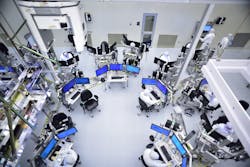As Personal Computer Business Slows, Intel Basks in Growth Everywhere Else
Despite butting heads with Advanced Micro Devices in personal computers, shuttering several bets in embedded software and smart glasses, and facing threats to its data center business in the form of Nvidia and Qualcomm, Intel continues to cash in on hardware that can store and process vast amounts of data.
That was reflected in Intel’s financial results for the first quarter of 2018, which were announced on Thursday. While the client computing business grew three percent to $8.2 billion, its other businesses jumped 25 percent to represent about 49 percent of Intel’s $16.1 billion in first quarter revenue, up from $14.8 billion over the same period last year.
“Coming off a record 2017, 2018 is off to a strong start, said Brian Krzanich, Intel’s chief executive officer, in a statement. “The strength of Intel’s business underscores my confidence in our strategy and the unrelenting demand for compute performance fueled by the growth of data.”
The data center business finished up 24 percent over the last year with revenues of $5.2 billion, boosted by the company’s new line of Xeon Scalable processors. Memory chip shortages, which have bolstered the price of flash memory, pushed Intel’s nonvolatile memory solutions group over a billion dollars of revenue, up 20 percent over the last year.
For the Internet of Things business unit, the first quarter closed at $840 million in total revenue, up 17 percent from the same quarter a year ago. The programmable solutions group, formerly Altera, reported $498 million, an increase of 17 percent over the last year, as server suppliers lapped up field-programmable gate arrays (FPGAs).
Bob Swan, Intel’s chief financial officer, said that the company beat its estimates for revenue, operating margins and earnings per share, which were 87 cents per share in the first quarter of the year, compared to Intel’s guidance of 70 cents. “Our data-centric strategy is accelerating Intel’s transformation,” he said in a statement.
Even though Intel beat what many Wall Street analysts had estimated, the company admitted it had run into trouble with the next generation of its chips. Currently, Intel is selling chips based on new 10-nanometer technology in low volumes, but it anticipates volume production to shift to next year as it sorts out yield issues.
The glowing financial results for the quarter compelled the company to raise its estimated revenue for the year to $67.5 billion, up $2.5 billion from its previous guidance. Intel forecast second quarter revenue of $16.3 billion on earnings per share of 85 cents with operating margin of about 30 percent.
About the Author
James Morra
Senior Editor
James Morra is the senior editor for Electronic Design, covering the semiconductor industry and new technology trends, with a focus on power electronics and power management. He also reports on the business behind electrical engineering, including the electronics supply chain. He joined Electronic Design in 2015 and is based in Chicago, Illinois.

